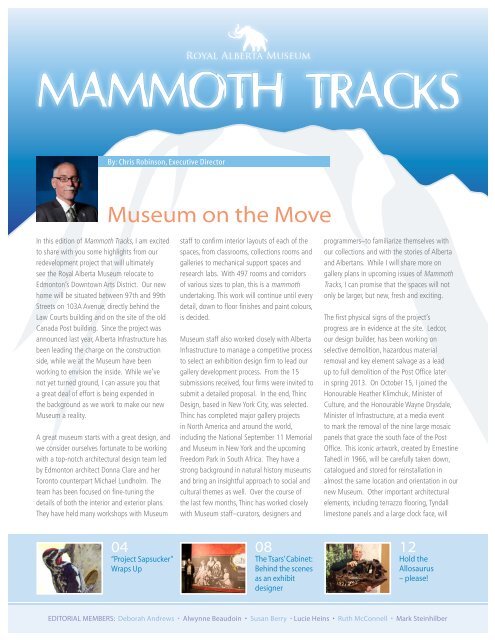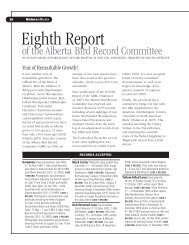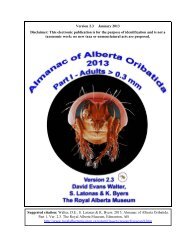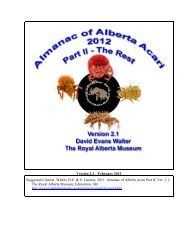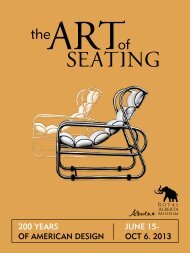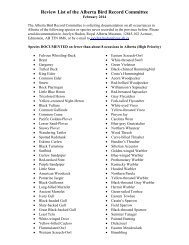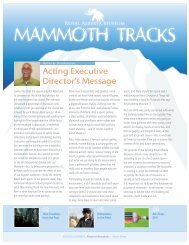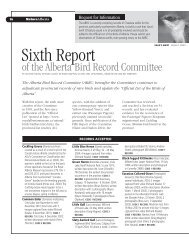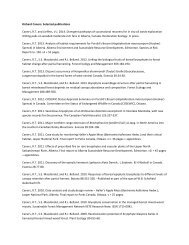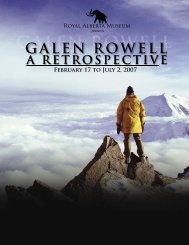MAMMOTH TRACKS - Royal Alberta Museum
MAMMOTH TRACKS - Royal Alberta Museum
MAMMOTH TRACKS - Royal Alberta Museum
Create successful ePaper yourself
Turn your PDF publications into a flip-book with our unique Google optimized e-Paper software.
<strong>MAMMOTH</strong> <strong>TRACKS</strong>By: Chris Robinson, Executive Director<strong>Museum</strong> on the MoveIn this edition of Mammoth Tracks, I am excitedto share with you some highlights from ourredevelopment project that will ultimatelysee the <strong>Royal</strong> <strong>Alberta</strong> <strong>Museum</strong> relocate toEdmonton’s Downtown Arts District. Our newhome will be situated between 97th and 99thStreets on 103A Avenue, directly behind theLaw Courts building and on the site of the oldCanada Post building. Since the project wasannounced last year, <strong>Alberta</strong> Infrastructure hasbeen leading the charge on the constructionside, while we at the <strong>Museum</strong> have beenworking to envision the inside. While we’venot yet turned ground, I can assure you thata great deal of effort is being expended inthe background as we work to make our new<strong>Museum</strong> a reality.A great museum starts with a great design, andwe consider ourselves fortunate to be workingwith a top-notch architectural design team ledby Edmonton architect Donna Clare and herToronto counterpart Michael Lundholm. Theteam has been focused on fine-tuning thedetails of both the interior and exterior plans.They have held many workshops with <strong>Museum</strong>staff to confirm interior layouts of each of thespaces, from classrooms, collections rooms andgalleries to mechanical support spaces andresearch labs. With 497 rooms and corridorsof various sizes to plan, this is a mammothundertaking. This work will continue until everydetail, down to floor finishes and paint colours,is decided.<strong>Museum</strong> staff also worked closely with <strong>Alberta</strong>Infrastructure to manage a competitive processto select an exhibition design firm to lead ourgallery development process. From the 15submissions received, four firms were invited tosubmit a detailed proposal. In the end, ThincDesign, based in New York City, was selected.Thinc has completed major gallery projectsin North America and around the world,including the National September 11 Memorialand <strong>Museum</strong> in New York and the upcomingFreedom Park in South Africa. They have astrong background in natural history museumsand bring an insightful approach to social andcultural themes as well. Over the course ofthe last few months, Thinc has worked closelywith <strong>Museum</strong> staff–curators, designers andprogrammers–to familiarize themselves withour collections and with the stories of <strong>Alberta</strong>and <strong>Alberta</strong>ns. While I will share more ongallery plans in upcoming issues of MammothTracks, I can promise that the spaces will notonly be larger, but new, fresh and exciting.The first physical signs of the project’sprogress are in evidence at the site. Ledcor,our design builder, has been working onselective demolition, hazardous materialremoval and key element salvage as a leadup to full demolition of the Post Office laterin spring 2013. On October 15, I joined theHonourable Heather Klimchuk, Minister ofCulture, and the Honourable Wayne Drysdale,Minister of Infrastructure, at a media eventto mark the removal of the nine large mosaicpanels that grace the south face of the PostOffice. This iconic artwork, created by ErnestineTahedl in 1966, will be carefully taken down,catalogued and stored for reinstallation inalmost the same location and orientation in ournew <strong>Museum</strong>. Other important architecturalelements, including terrazzo flooring, Tyndalllimestone panels and a large clock face, will04“Project Sapsucker”Wraps Up08The Tsars’ Cabinet:Behind the scenesas an exhibitdesigner12Hold theAllosaurus– please!EDITORIAL MEMBERS: Deborah Andrews • Alwynne Beaudoin • Susan Berry • Lucie Heins • Ruth McConnell • Mark Steinhilber
<strong>MAMMOTH</strong> <strong>TRACKS</strong>On October 15, 2012 Ministers Wayne Drysdale (Infrastructure) and Heather Klimchuk (Culture) assisted in the removal of a piece of the Ernestine Tahedl mosaic mural from thesouth side of the old Post Office building in downtown Edmonton. The mosaic pieces will be preserved and incorporated into the new <strong>Royal</strong> <strong>Alberta</strong> <strong>Museum</strong>. This event was our“shovel in the ground” day! Also present at the event were: Chris Robinson (<strong>Museum</strong> Executive Director), Stephen Mandel (Mayor of Edmonton), Peggi Ferguson-Pell (President,Friends of <strong>Royal</strong> <strong>Alberta</strong> <strong>Museum</strong> Society) and Ann Ramsden (<strong>Alberta</strong> <strong>Museum</strong>s Association).be salvaged and creatively re-used in the newbuilding, providing continuity between oldand new. Sean Moir, Curator of Military andPolitical History, has also selected a number ofPost Office-related artifacts, including interiorsigns, old sorting stations and letter boxes,ensuring that the site’s history is preserved andrespected.To give you a better sense of what the new<strong>Royal</strong> <strong>Alberta</strong> <strong>Museum</strong> will look like and howit will be situated, we recently opened a smallexhibition, entitled <strong>Museum</strong> on the Move,stretching from the main lobby to our caféentrance. It features the architectural modelfrom the design-build competition and severallarge renderings of both interior and exteriorviews. This exhibit will evolve as the new<strong>Royal</strong> <strong>Alberta</strong> <strong>Museum</strong> takes shape. Soon, ourcafé display cases will be enlisted to test andprototype display ideas for the new building, sostop by often to see what’s happening.Seven hundred words is not nearly sufficientto capture the excitement or the intensityof the work now going on with <strong>Museum</strong>redevelopment–in both building and gallerydesign – but I hope you have a better sense ofwhere we are going and what the future holds.It is a great privilege to be part of developinga new <strong>Museum</strong>, and I look forward to sharingour progress with you.2 <strong>Royal</strong> <strong>Alberta</strong> <strong>Museum</strong> Mammoth Tracks Newsletter
INTER 2013Monitoring Fishes in <strong>Alberta</strong>:A shocking storyBy: Mark Steinhilber, Curator of Ichthyology, and Sean McFadden, Assistant Curator of IchthyologyThis past summer the <strong>Alberta</strong> Biodiversity Monitoring Institute (ABMI), inpartnership with <strong>Alberta</strong> Energy and Sustainable Resource Development(ESRD) and the <strong>Royal</strong> <strong>Alberta</strong> <strong>Museum</strong> (RAM), launched a pilot programto test protocols for monitoring fish populations in <strong>Alberta</strong>. MarkSteinhilber and Sean McFadden from the <strong>Museum</strong>’s Ichthyology programspent three weeks assisting with a rather shocking component of thisstudy. Twenty-seven rivers and streams in the Fort McMurray area wereelectrofished to capture and document the fishes in these watersheds.Very simply, electrofishing involves introducing an electric currentinto the water. The current briefly stuns fish and allows researchers toscoop up the catch with dip nets– hopefully before the fish regain theircomposure and dart away! In small creeks, a backpack electrofisher isoften used. With the power generating unit carried on the operator’sback, a wand-like positive electrode is swept through the water whilethe negative electrode–a bare cable, often called a “rat-tail”–trailsbehind. The electric field generated between these electrodes causesthe fish’s muscles to contract, sometimes preventing it from swimmingand sometimes forcing it to swim toward the positive electrode. Thefish can’t help it–the current in the water mimics the electrical impulsesthat normally travel to the fish’s muscles when it swims. The temporarilyincapacitated specimen is then netted with a dip net, weighed, measuredand released.power is applied?” Well, that could happen if operators aren’t careful.Insulated chest waders and linesman’s gloves are worn at all times.The dip nets are made of fibreglass so that they, too, do not conductelectricity. Operators must be trained in the use of the equipment andprocedures are in place to ensure that everyone knows what to do,particularly if something goes wrong (like somebody slips and falls in thewater over their waders). When done properly, the procedure is very safe.But every now and then, a scooper who accidently steps directly on thenegative electrode with a sweaty wader boot can get a gentle reminderthat it’s time to head back to camp and put on dry clothes.In larger rivers, a boat shocker is used. In this case, the positiveelectrodes comprise two clusters of cables hanging from booms off thefront of the boat, with the boat itself acting as the negative electrode.Typically, two “scoopers” stand on a platform at the front of the boatand wait for fish to either float to the surface or come tearing over tothe electrode when the power is applied. In large creeks or small rivers,yet another form of the same type of unit is used. A positive electrode istossed from a small boat into likely fish-holding sites. While the power isapplied, fish actually follow the positive electrode as it’s pulled back tothe boat, where the scoopers do their thing.You may be wondering, “Why aren’t the electrofishing peoplethemselves stunned or forced to swim to the positive electrode when theMark Steinhilber and Sean McFadden launch an electrofishing boat in the GregoireRiver near Fort McMurray.3
<strong>MAMMOTH</strong> <strong>TRACKS</strong>By: Susan Berry, Curator of EthnologyArctic 4Exploring tales and traditions from Canada’s NorthThis winter, the <strong>Royal</strong> <strong>Alberta</strong> <strong>Museum</strong>celebrates Edmonton’s northern connectionswith a series of new feature exhibitions.The series kicked off in November with theopening of Inuujaq: Dolls of the CanadianArctic. This colourful exhibition brings together80 dolls from 19 communities. The dolls arearranged by community of origin, highlightingregional differences in clothing styles, materials,and doll-making techniques. Whether madeas a child’s playmate or for sale to a collector,each doll was created with a commitment toauthenticity and an eye for detail.Inuujaq: Dolls of the Canadian Arctic runsthrough April 28 in the Feature Gallery.Cold Recall: Roald Amundsen’sReflections from the Northwest PassageThe exhibition features large-scalereproductions of lantern slides and otherimages taken by the famed Norwegian explorer,who in 1905 became the first man to navigatethe Northwest Passage. Scenes of life aboardthe expedition’s ship, Gjoa, of equipment usedin making magnetic observations, and of Inuitindividuals who assisted the expedition areilluminated by Amundsen’s own commentary.Cold Recall: Roald Amundsen’s Reflections fromthe Northwest Passage runs through April 28 inthe Orientation Gallery.Irene Avaalaaqiaq: Myth and Reality“The stories my grandmother told me are fromthe time when animals used to talk like humanbeings. . .They stopped talking not very longago.” –Irene AvaalaaqiaqAn exhibition of 16 wall hangings by masterInuit artist Irene Avaalaaqiaq opens in ourfeature gallery on February 16. Bold designsand bright colours are signature elements ofAvaalaaqiaq’s work. So, too, is storytelling.Raised by her grandparents after her mother’searly death, Avaalaaqiaq grew up on the land.Many of her wall hangings interpret stories sheheard as a child about the time when animalstransformed into humans–and vice versa.Irene Avaalaaqiaq: Myth and Reality runs fromFebruary 16 through May 20 in the FeatureGallery.Echoes in the Ice: History, Mysteryand Frozen CorpsesThe doomed Franklin expedition of 1845-48haunts the Canadian imagination. Ever sincethe ships Erebus and Terror disappeared ontheir search for the elusive Northwest Passage,mystery has surrounded the fate of Sir JohnFranklin and his crew. Why did the expeditionfail so spectacularly? What catastrophe felledFranklin and many of his crew–and whatbecame of the survivors? What role, if any, didcannibalism play? Presenting the results ofrecent forensic research along with artifactsHusband and Wife, Irene Avaalaqiaq, 1999. As a couplemakes their way home through the dusk, large blackboulders surrounding them turn into menacing humanheads. The man prepares to escape by changing hishead into a goose’s, while his wife transforms into aptarmigan (head), wolf (arm) and fish (body). Ravenswith human heads fly down to help. Avaalaaqiaq oftenportrays birds, who represent freedom and escape, ashelping spirits.recovered from a site where at least 11 crewmembers perished, the feature exhibitionEchoes in the Ice investigates these and otherintriguing questions.The lost Franklin expedition has long inspiredartists as well as scientists, and collages byartist Rik van Glintenkamp form an integralpart of this exhibition. Incorporating imagesfrom historic photos and archival documents,they portray the achievements of 20 individuals,from Martin Frobisher to Roald Amundsen,who shared Franklin’s passion for Arcticexploration. The exhibition also examines howcontemporary researchers are investigatingthe impact of climate change on the samelandscapes that held Franklin’s ships ice-boundsome 160 years ago.Echoes in the Ice: History, Mystery and FrozenCorpses runs from February 16 throughMay 20 in the Feature Gallery.Inuujaq: Dolls of the Canadian ArcticFrom the collection of the <strong>Royal</strong> <strong>Alberta</strong> <strong>Museum</strong>, the TracyCollection, the Aarts Collection, the A. E. Anfi ordsen Collection,the Douglas & Struthers Collection, the Lakey Collection, the LeeCollection, the Manson Collection, the Newton Collection, the Dr.Nancy Wachowich Collection and other private collections.Guest Curators: Bill & Michelle TracyCold Recall: Roald Amundsen’s Reflections from theNorthwest PassageFrom The <strong>Royal</strong> Norwegian Embassy CollectionIrene Avaalaaqiaq: Myth and RealityFrom the Collection of the MacDonald Stewart Art Centre,Guelph, OntarioEchoes in the Ice: History, Mystery and Frozen CorpsesPrisonniers de la glace: Histoire, mystère et corps gelésA co-production of Gone West Productions and the CanadaScience and Technology <strong>Museum</strong>, with the generous support ofNatural Resources Canada and Parks Canada Agency.Une co-production de Gone West Productions et le Musée dessciences et de la technologie du Canada, avec le génVreux appuide Ressources naturalles Canada et l’Agence Parcs Canada.6 <strong>Royal</strong> <strong>Alberta</strong> <strong>Museum</strong> Mammoth Tracks Newsletter
<strong>MAMMOTH</strong> <strong>TRACKS</strong>By: Michelle Weremczuk, Exhibit DesignerThe Tsars’ Cabinet:Behind the scenes as an exhibit designerthan the gallery could provide on its own. We also communicate with oursecurity staff to determine if special measures must be taken to securethe artifacts’ safety. Once this is taken care of, we can begin to thinkcreatively.Michelle Weremczuk, Exhibit Designer, The Tsars’ CabinetAs an exhibit designer, our work begins months before we open ourfeature exhibitions to the public. The Tsars’ Cabinet recently closedafter three months on display but it took eight months to bring it to life.When exhibitions travel to the <strong>Royal</strong> <strong>Alberta</strong> <strong>Museum</strong>, graphic designers,production artists, curators, conservators, managers and marketingspecialists put a great deal of effort into its production. Here is a look atthe design process involved in producing The Tsars’ Cabinet.As an exhibit designer, it is my role to translate the core message of anexhibition into a physical presence that visitors can access and learnfrom. In this case, I dealt with case layouts, gallery floor plans, colourchoices and thematic elements. Initial design of any exhibition beginswith building a 3D model on the computer. This helps us determinewhich display cases we should use based on the sizes and groupings ofobjects provided by the exhibition vendor. It’s at this stage that we pulltogether the information that allows us to determine the gallery floorplan. With the help of our Conservation department, we determine if anycases need to be customized for the preservation of artifacts. With TheTsars’ Cabinet, approximately half of the cases required more humidityWorking with the graphic design team, we make decisions aboutcreative solutions for text design and “way-finding”. We usually haveto fit a lot of text into small cases, so coming up with visually pleasing,easily understood labels is tricky. For this exhibition, we wanted to takevisitors on a journey through the history of the Romanovs while alsoallowing them to appreciate the brilliance of the entire collection at aglance. When entering the gallery, the feature wall and embellishmentsled the viewer in and to the left. Glass cases were chosen so thatvisitors could take in the sheer volume of artifacts on display. Thetransitioning of colour from one section of the exhibition to anotherprovided way-finding through all four sections of the exhibition. Goldvinyl decals mounted on the walls led the viewer through the gallery,and decorative wallpaper and chandeliers further enhanced the look ofluxe. The chandeliers reflected along the glass cases, magnifying theirvisual impact. All these elements were installed prior to the arrival of theexhibition’s artifacts.Once they’d arrived, the artifacts had to sit and acclimate for a weekinside the gallery. When we finally started unpacking them, reports hadto be made of the condition of all artifacts before they were installed incases. For The Tsars’ Cabinet, over 200 pieces were placed within a spanof five days. Exhibition installation requires a lot of time and effort by ateam of experts. Working on this particular exhibition, with this team ofpeople, was an incredibly rewarding and rare experience!8 <strong>Royal</strong> <strong>Alberta</strong> <strong>Museum</strong> Mammoth Tracks Newsletter
INTER 2013Questions and Collections III:Research at the <strong>Museum</strong>By: Alwynne Beaudoin, Curator of Quaternary EnvironmentsAll lectures are FREE · 7pm · <strong>Museum</strong> Theatre · Visit before the lectures, from 5–7 pm, to enjoy the galleries and <strong>Museum</strong> ShopOur popular winter lecture series returns with six presentations focusingon new discoveries, partnerships and projects at the <strong>Museum</strong>. Twopresentations feature recently-discovered invertebrate species, two focuson creativity and transformation of materials to art, and two highlightexhibitions old and new. Through fieldwork, outreach and collaborations,projects at the <strong>Museum</strong> often extend well beyond our walls, involvingother organizations and colleagues far and wide. Two lectures highlightimportant partnerships – through David Walter’s research with the<strong>Alberta</strong> Biodiversity Monitoring Institute and Bill and Michelle Tracy’sdevelopment of the Inuujaq: Dolls of the Canadian Arctic exhibition.From mountains to mites, and wasps to weaving, there’s something foreveryone in our Questions and Collections!February 13Dancing on the Head of a Pin: Unravelling nature,one mite at a timeDavid Evans Walter, <strong>Alberta</strong> Biodiversity Monitoring InstituteJanuary 30Revealing the Hidden Stories in Wild <strong>Alberta</strong>’sBig Horn Sheep DioramaAlwynne B. Beaudoin, Curator, Quaternary EnvironmentsLook beyond the animals in the Big Horn Sheep diorama and find storiesof mountain building, ancient volcanoes, flowing ice, tilted trees, climatechange and adventurous travellers. There’s a lot packed into this scene!Imagine animals so small they appear insignificant. Then imagine seeingmites up close and learning that they are bizarrely beautiful, incrediblyinteresting and critical to natural and human ecosystems. Sound farfetched?Come and find out.9
<strong>MAMMOTH</strong> <strong>TRACKS</strong>And there's more…February 27Paper Wasps: The adventures of species discoveryin the 21 st centuryMatthias Buck, Assistant Curator, Invertebrate ZoologyMarch 27Trench Art: From tools of war to works of “art”Sean Moir, Curator, Military and Political HistoryPhoto: Cheung and BuckWorldwide, many thousands of species still await discovery. Hear a taleof scientific determination and serendipity, old challenges and novelapproaches, as we discover two new species in a seemingly well-knowngroup of insects in North America’s backyards!March 13Hand Weaving: An <strong>Alberta</strong>n historyCathy Roy, Curator, Western Canadian HistoryThe name trench art dates from the First World War when soldiers,confined for months in trenches crisscrossing the Belgian and Frenchfrontiers, created objects from spent artillery shells. The name, however, ismisleading. Come and discover why.April 10Speaking with DollsBill Tracy, Guest Curator, Inuujaq: Dolls of the Canadian Arctic<strong>Alberta</strong>n weavers were at the forefront of the hand weaving resurgenceof the mid-twentieth century. How did this isolated region become soinfluential? Hear about ongoing research in the Western CanadianHistory program.The dolls in the Inuujaq: Dolls of the Canadian Arctic exhibition mayappear silent, but that doesn’t mean they don’t have a lot to say. Join usand listen to their stories.10 <strong>Royal</strong> <strong>Alberta</strong> <strong>Museum</strong> Mammoth Tracks Newsletter
INTER 2013A celebration of the joy of life “joiede vivre” with a French Canadian twist:Mammoth Night a resounding success!By: Karène Gervais, Bilingual Gallery InterpreterThe holiday spirit was truly felt at the <strong>Royal</strong> <strong>Alberta</strong> <strong>Museum</strong> thisyear. On November 30, Mammoth pass holders and members of theFrancophone community were invited to an exclusive, fun-filled eveningat the <strong>Museum</strong>. The evening was sponsored in part by the FrancophoneSecretariat and celebrated <strong>Alberta</strong>’s rich French Canadian heritage.Participants were encouraged to experience cultural festivities througha variety of activities. Younger visitors expressed their creativity throughtraditional candle-making. Santa Claus/Père Noël spread good cheerto young and old alike. A temporary exhibition on the Francophoneimprint in our province also drew the interest of many visitors. This wasnicely complemented by a display of French Canadian artifacts from theRAM’s collection, curated and interpreted in person by Assistant Curatorof Western Canadian History, Lucie Heins. The “crème de la crème” ofEdmonton-based Francophone cultural performers animated the evening,creating a lively atmosphere through interactive storytelling, live musicand rhythmic workshops in spoons and wooden dancing men led byLes Bûcherons. This was followed by a special performance of FrenchCanadian “jigging” by the dance troupe Zephyr. The lively and joyousatmosphere was felt by many!Yippee! Another successful and fun-filled event at the <strong>Museum</strong>The Zephyr dance troupe performs a traditional French Canadian “jig”Someone loves Santa/Père Noël!Lively spoons and wooden dancing men workshops wereanimated by Les BûcheronsMaking beeswax candles11
<strong>MAMMOTH</strong> <strong>TRACKS</strong>Hold the Allosaurus – Please!By: Peggi Ferguson-Pell, President, FRAMSNothing brings history alive like being ableto see, touch and feel the past. And for thethousands of <strong>Alberta</strong>n school children whovisit the <strong>Museum</strong>’s Discovery Room each year,something exciting has just been added to thecollection – a life-size replica of an Allosaurusskull with some pretty impressive teeth!Allosaurus – meaning “different lizard” –was a large, carnivorous dinosaur that lived145-155 million years ago in the late Jurassicinterval. Moving on two legs, Allosaurusaveraged about 8.5 metres long and isconsidered one of the top predators of its day.The Allosaurus cast was purchased anddonated to the Discovery Room by the Friendsof <strong>Royal</strong> <strong>Alberta</strong> <strong>Museum</strong> Society (FRAMS),which has been a major supporter of theDiscovery Room for more than three years now.As you may know, FRAMS recently celebratedits 30th anniversary. In recognition of thismilestone, the FRAMS board agreed that thepurchase of something special that would helpour school children experience the fascinatingage of dinosaurs would be a wonderfuladdition to the program.The Discovery Room is a curriculum-based,hands-on learning experience for childrenbetween the ages of four and eight. ThereFRAMS Treasurer, Ken Kouri, gently cradles the life-size replica Allosaurus skull recently purchased by FRAMSfor the <strong>Museum</strong>’s Discovery Roomare four themed stations in the room, and theAllosaurus cast will be used for a hands-onexperience at the Prehistoric Pals station.More than 6,000 of <strong>Alberta</strong>’s studentsparticipate in Discovery Room activities duringthe school year, making it the most highlyattended school program at the <strong>Museum</strong>.We would like to give our sincere thanks toall our FRAMS members –and to everyonewho supports the <strong>Museum</strong> through theircontributions to FRAMS–for enabling us tosupport and enhance this vital educationalprogram. Thank you!If you would like to make a donation to helpsupport FRAMS or would like to learn moreabout us, please visit our website at:www.framsociety.ca. FRAMS membershipinvolves a tax-deductible donation of $20 peryear and includes invitations to our Talk & Tourseries and private preview evenings at the<strong>Museum</strong>. We invite you to join us!12 <strong>Royal</strong> <strong>Alberta</strong> <strong>Museum</strong> Mammoth Tracks Newsletter
INTER 2013Exhibitions and EventsInuujaq: Dolls of the Canadian Arctic (Feature Gallery)On now until April 28, 2013River’s Edge: Petrified tree stump (Feature Gallery)Here until April 2013Cold Recall: Roald Amundsen’s Reflections from the Northwest Passage(Orientation Gallery)On now until April 28, 2013Questions and Collections III: Research at the <strong>Museum</strong>(FREE Lecture Series – <strong>Museum</strong> Theatre)Jan. 30, Feb. 13 & 27, Mar. 13 & 27, Apr. 10, 2013Family Day – Exhibits and Programming – All FREEFeb. 18, 2013Echoes in the Ice: History, Mystery, and Frozen Corpses (Feature Gallery)February 16 – May 20, 2013Irene Avaalaaqiaq: Myth and Reality (Feature Gallery)February 16 – May 20, 2013Maple Memories EventMarch 2, 2013Chop Suey on the Prairies (Feature Gallery)April 20, 2013 – April 27, 2014Art of Seating: 200 Years of American Chair Design (Feature Gallery)June 15, 2013 – October 6, 2013* Please note: The <strong>Museum</strong> will be closed on Thursdays in March for maintenance.Check our website, www.royalalbertamuseum.ca, for current information.13


